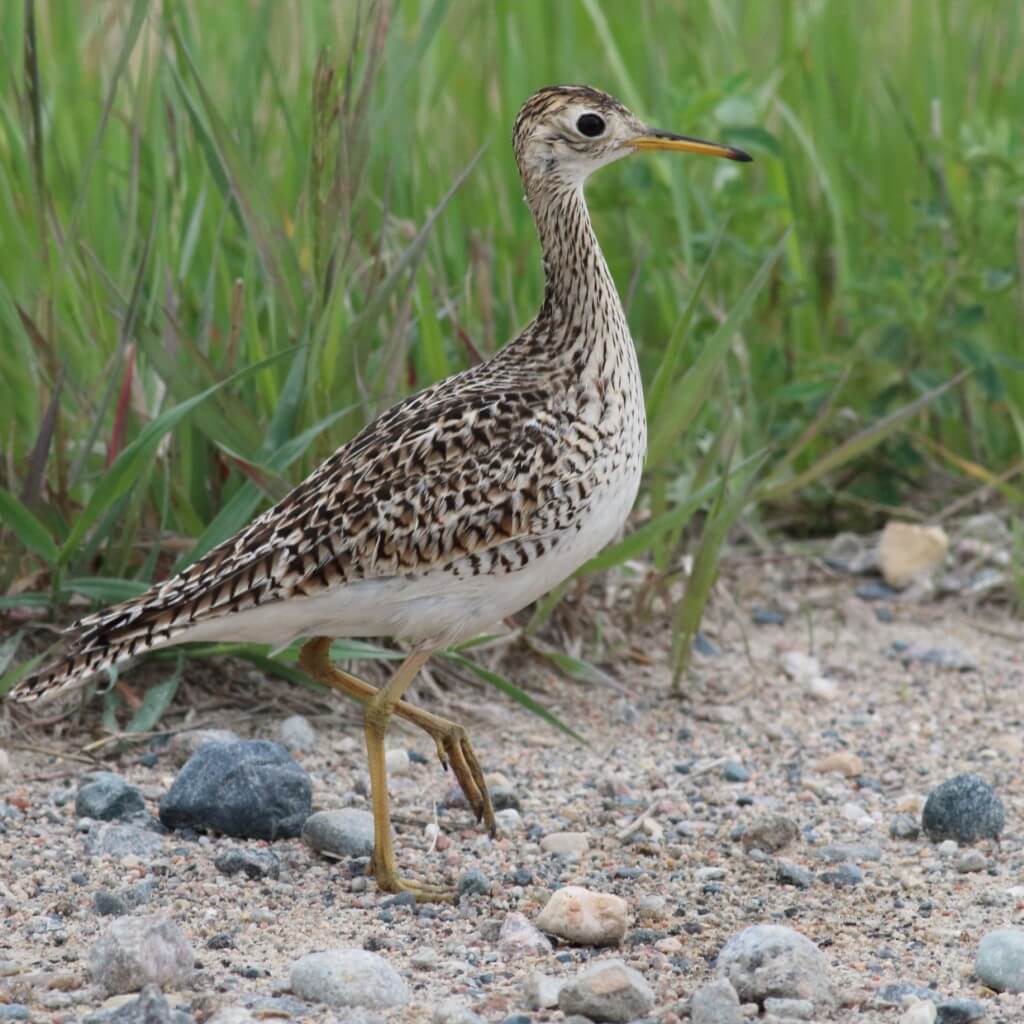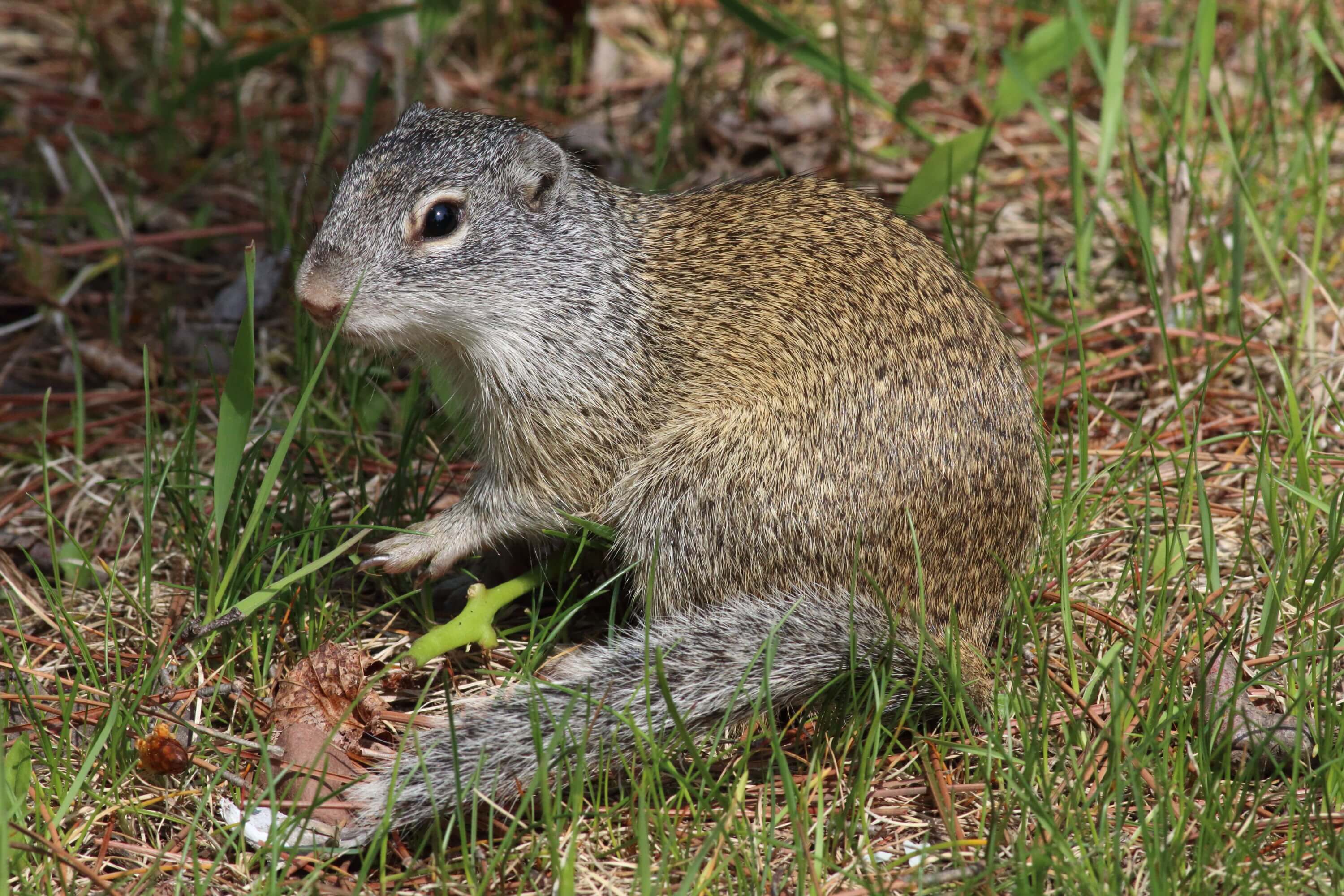Warblers and Woodcock in Minnesota's Wild North
June 3, 2015 Blog #20 of my North with the Spring journey:
From northern Wisconsin, I traveled west to Minnesota and the north shore of Lake Superior. Based out of Gooseberry Falls State Park, about an hour northeast of Duluth, my wife Carol and I toured the boreal forests of this marvelous area.

Upland Sandpiper at Felton Prairie. Photo by Bruce Beehler
The first night, on the way in from the airport, Carol saw a silvery timber wolf on the roadside as we drove along highway 61. White spruce and aspens marked our campsite, where Ruby-crowned Kinglets, Chestnut-sided and Yellow-rumped Warblers, and White-throated Sparrows serenaded us each morning. Temperatures hovered near freezing at dawn, and strong winds blew off Lake Superior. Ground squirrels, red squirrels, and chipmunks visited us at our picnic table for treats.

At our picnic table, we had visitors like this ground squirrel. Photo by Bruce Beehler
In the interior, which we visited each morning, we heard Ruffed Grouse drumming and chased down boreal warblers—Nashville, Tennessee, Canada, Magnolia, Black-throated Green, Mourning, Yellow-rumped and more. Sadly, we missed Connecticut Warbler.

North of Duluth, we saw many warblers, including Mourning Warbler. Photo by Bruce Beehler
Headwaters of a Great River
At Itasca State Park's 32,000 acres of natural habitat, I was amazed to see the headwaters of the Mississippi. They were no more than a few yards wide, winding among a mix of lakes, bogs, and mixed-boreal forest. Right at the headwaters a lovely adult male Black-backed Woodpecker surprised us, flying to a large white spruce and allowing us to gaze for more than a minute at this rare creature.

We saw a Black-backed Woodpecker in Itasca State Park, near the headwaters of the Mississippi River. Photo by ShutterShock
The following day we wandered westward, to Felton Prairie, where in spite of strong winds we successfully searched out Upland Sandpiper (pictured, top) and Greater Prairie Chicken. This wide-open expanse of prairie was quite a change from the closed boreal forest I had been birding the previous several days. As with Crex Meadows, this lovely remnant prairie is carefully managed, especially with periodic fire, to maintain its special qualities that the birds love.
Searching for Woodcock
My last birding day in Minnesota was spent at Tamarac National Wildlife Refuge. Tamarac's 40,000 acres are a mix of lakes, marshes, bogs, and mixed upland forests, and targeted habitat management is enriching its songbird and wildlife values year by year.
There I visited with Peter Dieser and Earl Johnson. Peter is an ABC field staffer working on habitat improvement for Golden-winged Warbler and American Woodcock. Earl Johnson is a retired state wildlife biologist who now works on banding and surveying American Woodcock. We went afield in search of these two elusive species.

Golden-winged Warbler have responded quickly to habitat management at Tamarac National Wildlife Refuge in Minnesota. Photo by Laura Erickson
Earl quietly showed us a nesting woodcock hen sitting on four eggs. It was amazing to see how camouflaged the sitting bird was—Earl spent quite some time describing where this bird sat in the grassy tangle before I could actually see it.
I saw various patches of forest that had been managed for these two species, which love early successional woodland and forest openings. I was amazed to see how effective this management could be in such a short time: One patch, treated two years ago, was filled with singing male Golden-wings. Another site, treated only a year ago, supported a singing male goldenwing and nesting woodcock. Build the habitat and they will come!
Note from the editor: Thank you so much for joining ABC Field Naturalist, Bruce Beehler, on his journey "North with the Spring." Stay tuned for highlights from his epic adventure in a post-trip wrap-up later this summer.
 Bruce Beehler is an ornithologist, conservationist, and naturalist. He is currently a Research Associate in the Division of Birds at the National Museum of Natural History, Smithsonian Institution, and is focused on research and writing about nature and natural history. Bruce has published ten books and authored dozens of technical and popular articles about nature. In 2007, Beehler was featured in a “60 Minutes” piece highlighting an expedition he led to the Foja Mountains in the interior of New Guinea in which scores of new species were discovered.
Bruce Beehler is an ornithologist, conservationist, and naturalist. He is currently a Research Associate in the Division of Birds at the National Museum of Natural History, Smithsonian Institution, and is focused on research and writing about nature and natural history. Bruce has published ten books and authored dozens of technical and popular articles about nature. In 2007, Beehler was featured in a “60 Minutes” piece highlighting an expedition he led to the Foja Mountains in the interior of New Guinea in which scores of new species were discovered.
The North with the Spring journey is supported by American Bird Conservancy and Georgia-Pacific.


















































